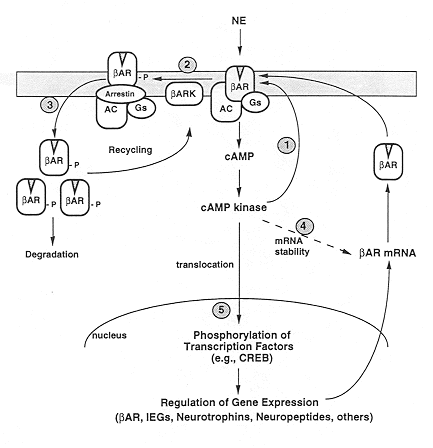
| Figure 5. |
 |
| Schematic illustration of multiple mechanisms underlying regulation of the bAR. One of the best characterized actions of bAR activation is regulation of the receptor itself, which involves several points controlling receptor function and expression. 1) bAR stimulation of the cAMP system results in phosphorylation of the receptor by cAMP-dependent protein kinase, which leads to uncoupling of the receptor from Gs. The activated protein kinase would also phosphorylate many other proteins, not shown in the Figure, which would then mediate many of the actions of bAR activation. 2) Prolonged activation of the receptor leads to phosphorylation by another kinase, bAR kinase (bARK), which only phosphorylates the agonist-activated form of the receptor. This results in binding of the receptor to b-arrestin, which competes with Gs and thereby inhibits bAR-stimulation of adenylyl cyclase (AC). 3) Loss of bARs from the membrane occurs when receptors are internalized and sequestered into intracellular vesicles. This pool of receptors is then available for either recycling back to the membrane or degradation. Such sequestration, internalization, degradation, and membrane re-insertion may be mediated via receptor phosphorylation and dephosphorylation involving the cAMP and/or bARK pathways. Another mechanism by which receptor activation leads to down regulation of the bAR is via regulation of receptor mRNA levels, which may occur by two primary mechanisms. 4) The level of receptor mRNA is regulated by the stability or half-life of the mRNA. Although the mechanisms responsible for regulation of mRNA stability have not been identified, they may also involve cAMP-dependent protein kinase. 5) The level of receptor mRNA is also regulated via changes in bAR gene transcription. This effect is mediated by the cAMP pathway and appears to involve the translocation of cAMP-dependent protein kinase catalytic subunit into the nucleus and the phosphorylation of constitutively expressed transcription factors (e.g., CREB). It might also depend upon the subsequent induction of other transcription factors [e.g., immediate early gene (IEG) products such as c-Fos]. In addition to regulation of receptor gene transcription, such regulation of transcription factors would mediate the effects of bAR activation on the expression of many other genes, for example, those for G-proteins, cAMP-dependent protein kinase, neurotrophins, and neuropeptides. This, in turn, would mediate many of the more long-term effects of bAR activation on brain function. |
published 2000